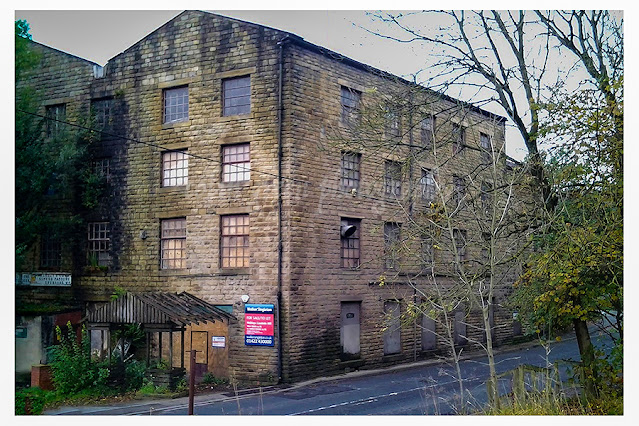Sunday, 12 November 2017
BMW Z3 and Z4.
Sunday, 5 November 2017
Early Morning Sunrise in Zeebrugge.
Saturday, 4 November 2017
Canal Wharf Saw Mills: A Story of Industry, Fire, and Redevelopment
Canal Wharf Saw Mills, built in 1851, occupied a prominent location in Hebden Royd, West Yorkshire, nestled between Mytholmroyd and Hebden Bridge. Its position alongside the A646 Burnley Road, the Rochdale Canal, and the River Calder proved both advantageous and detrimental. While the waterways facilitated transportation during its industrial heyday, they also subjected the mill to repeated flooding, ultimately contributing to its decline.
Originally a working sawmill, the site later became home to the renowned Walkley Clogs. Tragedy struck in 1990 when an arson attack caused significant fire damage. The mill was subsequently refurbished and transformed into a popular tourist attraction, featuring a clog-making visitor center and various craft shops. However, the influx of visitors created traffic congestion, and despite several attempts, planning applications for necessary road improvements were repeatedly rejected. This ultimately led to the closure of the tourist attraction in the late 1990s.
The mill then sat vacant, a target for various redevelopment proposals, primarily for apartments. Each application, however, was denied due to concerns about flooding, access, and inadequate parking. The final blow came in 2019 when another devastating fire ravaged the already dilapidated structure, leading to its demolition shortly thereafter.
For nearly two years, the cleared site remained empty. Recently, however, planning permission has been granted for the construction of residential housing, marking a new chapter in the history of this once-bustling industrial location.
These photographs, captured on November 24, 2013, with a Samsung Galaxy Tablet, document the mill in its abandoned state before the final fire and demolition. Clicking any image should open a link in another window to my Colin Green Photography store on Zazzle.
Saturday, 28 October 2017
Majestic Ribblehead Viaduct: A Feat of Victorian Engineering
The Ribblehead Viaduct, a magnificent testament to Victorian engineering, has captivated visitors for generations. My own visit in April 2015, armed with my trusty Polaroid IS2132 digital bridge camera, only deepened my appreciation for this iconic structure. Having long desired to see it in person, I seized the opportunity while exploring nearby Kirkby Lonsdale.
Also known as Batty Moss Viaduct, this impressive structure stretches across the valley approximately 13 miles north of Settle and 73 miles south of Carlisle, carrying the renowned Settle-Carlisle Railway. Its presence is a powerful reminder of the ambition and hardship that characterized the railway's construction.
Getting there is part of the experience. The Ribblehead Railway Station sits adjacent to the viaduct, offering a scenic train journey of about 1 hour and 20 minutes from Leeds. For those driving, the B6255 road, connecting Hawes and Ingleton, passes right by.
Designed by the skilled engineer John Sydney Crossley, the viaduct's construction was a monumental undertaking. The first stone was laid on October 12, 1870, and the last in 1874. Imagine the scene: a thousand "navvies" toiling tirelessly, establishing temporary shanty towns on the moors for themselves and their families. These settlements, bearing names inspired by Crimean War victories, affluent London districts, and biblical figures, paint a vivid picture of the era. However, this ambitious project came at a cost. Smallpox epidemics and industrial accidents claimed the lives of approximately one hundred workers during construction, a stark reminder of the dangers they faced. The graveyard at Chapel-le-Dale holds around 200 burials from this period, a poignant testament to their sacrifice, and the church there houses a memorial to these railway workers.
The line over the viaduct first opened to goods traffic on August 3, 1875, but passenger trains didn't begin running until May 1, 1876, following an inspection and approval by Colonel F. H. Rich of the Board of Trade. Even in later years, the viaduct has seen its share of drama. In 1964, several brand new Humber cars were infamously blown off their freight train carriages while crossing the viaduct.
The sheer scale of the Ribblehead Viaduct is breathtaking. It spans 440 yards (400 m) in length and towers 104 feet (32 m) above the valley floor at its highest point. Comprising twenty-four arches, each with a 45-foot (14 m) span, and foundations reaching 25 feet (7.6 m) deep, the viaduct is a masterpiece of structural engineering. The ingenious design incorporates thicker piers every sixth arch, providing a crucial safeguard against potential collapse. A subtle gradient of 1:100 exists along the viaduct, with the north end sitting 13 feet (4.0 m) higher than the south. The construction consumed a staggering 1.5 million bricks, with some limestone blocks weighing a hefty 8 tonnes each.
As the longest viaduct on the Settle-Carlisle Railway, Ribblehead Viaduct holds a prominent place in railway history. Ribblehead railway station lies less than half a mile to the south, while the Blea Moor Tunnel, the line's longest tunnel, lies to the north. The viaduct stands near the foot of Whernside, adding to the stunning natural beauty of the area.
The Settle-Carlisle Line itself is a vital artery, one of three major north-south routes in Britain. Its survival is a testament to public passion. In the 1980s, British Rail attempted to close the line, citing safety concerns and the high cost of repairs. The viaduct, they claimed, was unsafe. A partial solution, implemented in 1985, involved singling the line across the viaduct and imposing a 30 mph speed limit. However, the closure proposals sparked widespread protests, ultimately leading to their retraction. The viaduct, along with the rest of the line, was repaired and maintained, ensuring its continued operation.
While Ribblehead is the longest, other impressive viaducts grace the Settle-Carlisle line, including the taller Smardale Viaduct (131 feet/40 m) and Arten Gill Viaduct (117 feet/36 m).
Today, the Ribblehead Viaduct continues to play a vital role. In 2016, it carried seven passenger trains from Leeds to Carlisle daily in each direction, alongside special long-distance excursions, often hauled by magnificent steam locomotives. Regular freight trains also utilize the route, relieving congestion on the West Coast Main Line. Keep an eye out for the Colas Rail timber train, a Friday afternoon fixture, often pulled by powerful Class 56 locomotives, and the limestone aggregate train from Arcow quarry, which requires a fascinating reversal maneuver at Blea Moor signal box. These regular workings, along with the stunning scenery, make a visit to the Ribblehead Viaduct a truly memorable experience.
Clicking any image below should open a link in another window to my Colin Green Photography store on Zazzle.
 |
| Ingleborough Peak, the 2nd highest mountain in Yorkshire can be seen in the distance. I climbed the steep embankment to take this picture. |
 |
| Although it may look different this picture was taken without accessing the track area. I lent across the fence having checked no trains were due. |
 |
| This picture was taken in August 1976, it shows the viaduct still crossed by 2 lines, it was singled in the 1980's, when once again it was being targeted for closure. |
Saturday, 21 October 2017
Journey Through Cumbria and Scotland: A Dashcam Time-Lapse
Experience the beauty of one of the UK's most scenic motorway stretches in this captivating time-lapse video! Filmed from my dashcam, this journey takes you on a 75-mile trip through stunning landscapes, from the edge of the Lake District to the Scottish border.
Our adventure begins near Burton in Kendal Services, just inside Cumbria, as we cross over from Lancashire. From there, we travel north on the motorway, offering glimpses of rolling hills and majestic mountains, even under less-than-ideal weather conditions. Keep an eye out for the dramatic climb to Shap Summit and the exhilarating descent that follows! The anticipation builds as we approach and cross the Scottish border, marking a transition into new territory.
This time-lapse condenses approximately 1 hour and 20 minutes of driving into a fast-paced 8-minute journey. The original footage was captured on Monday, October 16, 2017, using a Vivitar DVR 783HD waterproof action cam.
Friday, 6 October 2017
Exploring Scammonden from the Bridge
During a recent trip near Scammonden, I took the opportunity to film the area from the bridge that crosses the M62. This bridge, a fascinating landmark in its own right, goes by several names: Scammonden Bridge, a name that recalls the village submerged during the construction of the motorway and dam; Rainbow Bridge, perhaps inspired by the views it affords; and Brown Cow Bridge, a local moniker referencing a now-closed inn.
The bridge carries the B6114 road over the M62, which at this point sits at over 310 metres above sea level. The exposed location makes it susceptible to strong winds, a factor that once led the now-closed local school to provide a taxi service for children crossing the bridge during particularly blustery weather. Beneath the bridge, the M62, a vital artery connecting Liverpool and Hull, stretches across the north of England. Just west of the bridge lies the highest point on any motorway in England.
My videos offer eight distinct views of the surrounding area, including Stott Hall Farm, the impressive overflow of Booth Wood Reservoir, the substantial Scammonden Dam, and the panoramic natural beauty of the landscape. One of the videos is presented as a timelapse to offer a condensed viewing experience. Both videos are complemented by the evocative sounds of Kevin MacLeod's "Digya."
Wednesday, 4 October 2017
The Silent Witness: St. Paul's Spire and the Stories it Holds
Standing tall against the sky, a lone spire points heavenward, a silent sentinel of a bygone era. This is all that remains of St. Paul's Church, a once magnificent structure that graced the landscape for over half a century. Opened in 1847 at a cost of a million pounds – a truly staggering sum in those days – the church served its community until 1912, before finally being demolished in 1931.
Today, only the Grade II listed spire remains, a poignant reminder of the grand church that once stood in its place. It stands proudly within the former burial grounds, now transformed into a peaceful rest garden. Imagine the stories this spire could tell, the generations it has witnessed come and go.
What makes this site even more intriguing is the history of its burials. While the headstones have been removed and repositioned, I understand that the bodies remain undisturbed beneath the tranquil surface of the garden. Burials continued here until as recently as 1969, a testament to the long and varied history of this place.
It's a fascinating thought, to wander through this serene space, knowing that beneath your feet lie the remains of those who lived and worshipped in the shadow of St. Paul's. The removal of the headstones, while perhaps necessary for creating a public space, adds an air of mystery. Who were these people? What were their lives like? The spire stands as a silent witness, guarding their secrets and connecting us to the past.
Next time you find yourself in the area, take a moment to visit St. Paul's Spire. Walk through the rest garden, breathe in the fresh air, and consider the lives lived and the stories whispered by the stones beneath your feet. It's a place where history and tranquility intertwine, a reminder that even in the quietest of spaces, stories can still be told.
 |
| The interior of the spire, not often seen but the opportunity was taken that day. |
A Glimpse into Maritime History: Admiralty Pier, Dover Postcard
There's something uniquely captivating about old postcards. They're not just pieces of paper; they're tiny time capsules, offeri...

-
Have you ever wondered about the imposing wall that lines a stretch of the Rochdale Canal in Todmorden? It's not just a simple retaining...
-
Passing through Brearley, a small village between Luddendenfoot and Mytholmroyd, West Yorkshire on the Route 66 of the national cycle netw...








































